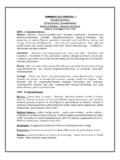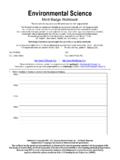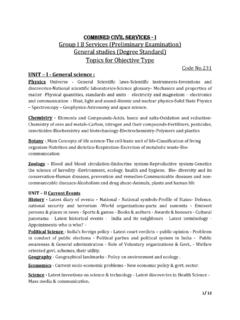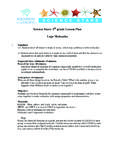Transcription of Predicting Products and Writing Equations - VDOE
1 Science Enhanced Scope and Sequence Chemistry Virginia Department of Education 2012 1 Predicting Products and Writing Equations Strand Nomenclature, Chemical Formulas, and Reactions Topic Investigating chemical reactions and Equations Primary SOL The student will investigate and understand how conservation of energy and matter is expressed in chemical formulas and balanced Equations . Key concepts include e) reaction types. Related SOL The student will investigate and understand that experiments in which variables are measured, analyzed, and evaluated produce observations and verifiable data. Key concepts include a) designated laboratory techniques; b) safe use of chemicals and equipment; c) proper response to emergency situations.
2 Background Information A chemical reaction is a process that leads to the transformation of one set of chemical substances to another. Chemical reactions can be either spontaneous, requiring no input of energy, or nonspontaneous, typically following the input of some type of energy, such as heat, light or electricity. Classically, chemical reactions encompass changes that strictly involve the motion of electrons in the forming and breaking of chemical bonds, although the general concept of a chemical reaction, in particular the notion of a chemical equation, is applicable to transformations of elementary particles as well as nuclear reactions. In a synthesis reaction, two or more simple substances combine to form a more complex substance.
3 Two or more reactants yielding one product is another way to identify a synthesis reaction. These reactions are in the general form: A + B AB For example, simple hydrogen gas combined with simple oxygen gas can produce a more complex substance, such as water. A decomposition reaction is the opposite of a synthesis reaction, where a more complex substance breaks down into its more simple parts. These reactions are in the general form: AB A + B In a single replacement reaction, a single uncombined element replaces another in a compound. In a double replacement reaction, parts of two compounds switch places to form two new compounds. This is when the anions and cations of two different molecules switch places, forming two entirely different compounds.
4 These reactions are in the general form: AB + CD AD + CB Redox reactions can be understood in terms of transfer of electrons from one involved species (reducing agent) to another (oxidizing agent). In this process, the former species is oxidized and the latter is reduced, thus the term redox. Though sufficient for many purposes, these descriptions are not precisely correct. Oxidation is better defined as an increase in oxidation number, and reduction as a decrease in oxidation number. In practice, the transfer of electrons will always Science Enhanced Scope and Sequence Chemistry Virginia Department of Education 2012 2 change the oxidation number, but there are many reactions that are classed as "redox" even though no electron transfer occurs (such as those involving covalent bonds).
5 Before undertaking these lab experiments, be sure your school s chemical hygiene plan allows for the use of the chemicals required. If you do not feel confident that your students have sufficient lab skills to safely do some of the reactions involving flammable materials, do those as demonstrations. These experiments can be conducted over several days as you introduce the types of reactions, or you can do them on one day as a review of the different types of reactions. Partners can work in larger groups to do certain assigned experiments and then present their results to the rest of the class either as a demonstration or simply as a discussion. Depending on the level of students knowledge at this point, they may write a word equation first, then translate that to a formula equation, and finally balance the equation; or they may write the balanced equation directly.
6 Students will need to know the positive results of the splint tests for the gases hydrogen, oxygen, and carbon dioxide. If they are not familiar with the splint tests for these gases, you can demonstrate them prior to the lab. (Hydrogen gas will pop when tested with a burning splint. Oxygen gas will relight a glowing splint. Carbon dioxide will extinguish a burning splint.) Solution concentrations are not typically crucial for most of the lab except the neutralization reaction. For that reaction, about equal drops of acid and base are needed to reach the neutralization point; hence, the molarity of the NaOH and HCl for this part are important. Materials Wooden splints pH paper or strips Plastic pipettes Test tubes in a variety of sizes Beakers in a variety of sizes Test tube rack Tongs Candle Scoop Burner Watch glass Ethanol Magnesium metal (ribbon form) Manganese dioxide (catalyst) 3% hydrogen peroxide solution Iron filings Zinc metal (Mossy zinc is fine.)
7 M HCl and M HCl (Exact concentration is not crucial.) Solid CuCO3 Solid (NH4)CO3 M KI (Exact concentration is not crucial.) Science Enhanced Scope and Sequence Chemistry Virginia Department of Education 2012 3 M Pb(NO3)2 (Exact concentration is not crucial.) Solid NaHCO3 Copper metal pieces M AgNO3 solution (Exact concentration is not crucial.) M NaOH and M HCl (These concentrations need to be equal to be accurate.) M Na2CO3 solution (Exact concentration is not crucial.) M CuSO4 (Exact concentration is not crucial.) Small pieces of Ca metal Phenolphthalein indicator Vocabulary acid, balance, base, chemical reaction, classify, combustion, decomposition, double replacement, endothermic, equation, exothermic, observation, oxidation, precipitate, prediction, redox reaction, single replacement, synthesis Student/Teacher Actions (what students and teachers should be doing to facilitate learning) Introduction 1.
8 Tell students that chemists observe what is happening in a chemical reaction and try to describe what is happening in a clear and concise way. A chemical equation uses formulas and symbols to describe the substances that are involved in a reaction, the physical state of the substances, the use of a catalyst, and the changes in energy that occur. In this experiment, you will perform a series of reactions and make careful observations of the changes that occur. Using simple tests and your knowledge of chemistry, you will identify the Products of the reactions. With this information, you will then write and balance chemical Equations to describe the reactions. Finally, you will classify the reactions as to type: combustion, oxidation, synthesis, decomposition, single replacement, double replacement, or acid-base.
9 Procedure Either demonstrate or have students conduct the following reactions. Have students write a balanced chemical equation for each reaction, showing the product (s), and classify the reaction as to type: combustion, oxidation, synthesis, decomposition, single replacement, double replacement, or acid-base. Some reactions may have more than one classification. Direct students to indicate in their balanced Equations all phases of matter (s, l, g) for reactants and Products . Also, have them indicate whether the reaction is exothermic or endothermic by adding energy as either a reactant or a product . 1. Place a very small amount no more than 4 drops of ethyl alcohol (ethanol, C2H5OH) on a watch glass on the lab table, and ignite it with a match.
10 Use crucible tongs to hold the match. CAUTION! Ethyl alcohol is very flammable. Remove all flammable materials from the lab area. 2 C2H5OH + 6 O2 4 CO2 + 6 H2O; combustion; exothermic. The alcohol burns with a nonluminous blue flame. If you turn off the lights, the flame will be more visible. Science Enhanced Scope and Sequence Chemistry Virginia Department of Education 2012 4 2. Ignite a very small piece (less than in.) of Mg metal in the burner flame. CAUTION! Magnesium metal burns with a very bright light. Do not stare directly at the flame. Remove all flammable materials from the lab area. 2 Mg + O2 2 MgO; oxidation; synthesis; exothermic. 3. Place a very small amount (fill only the very tip of your scoop) of solid catalyst, MnO2, in a test tube that is half filled with 3% hydrogen peroxide.

















